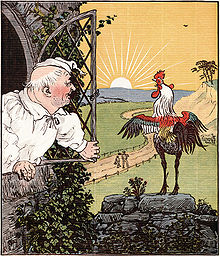This Is the House That Jack Built
| "This Is the House That Jack Built" | |
|---|---|
| Roud #20584 | |

Randolph Caldecott illustration from The complete collection of pictures & songs, published 1887. Digitally restored.
|
|
| Song | |
| Written | England |
| Published | 1755 |
| Form | Nursery rhyme |
| Writer(s) | Traditional |
| Language | English |
"This Is the House That Jack Built" is a popular British nursery rhyme and cumulative tale. It has a Roud Folk Song Index number of 20584. It is Aarne–Thompson type 2035.
This is perhaps the most common set of modern lyrics:
Some versions use "cheese" instead of "malt", "priest" instead of "judge", "cock" instead of "rooster", the older past tense form "crew" instead of "crowed", or "chased" in place of "killed". Also in some versions the horse, the hound, and the horn are left out and the rhyme ends with the farmer.
It is a cumulative tale that does not tell the story of Jack's house, or even of Jack who built the house, but instead shows how the house is indirectly linked to other things and people, and through this method tells the story of "The man all tattered and torn", and the "Maiden all forlorn", as well as other smaller events, showing how these are interlinked.
It has been argued that the rhyme is derived from an Aramaic hymn Chad Gadya (lit., "One Young Goat") in Sepher Haggadah, first printed in 1590; but although this is an early cumulative tale that may have inspired the form, the lyrics bear little relationship. It was suggested by James Orchard Halliwell that the reference to the "priest all shaven and shorn" indicates that the English version is probably very old, presumably as far back as the mid-sixteenth century. There is a possible reference to the song in The Boston New Letter of 12 April 1739 and the line: "This is the man all forlorn, &c". However, it did not appear in print until it was included in Nurse Truelove's New-Year's-Gift, or the Book of Books for Children, printed in London in 1755. It was printed in numerous collections in the late eighteenth and early nineteenth centuries.Randolph Caldecott produced an illustrated version in 1878.
Cherrington Manor, a handsome timber-framed house in North East Shropshire, England, is reputed to be the actual house that Jack built. There is a former malt house in the grounds.
...
Wikipedia
